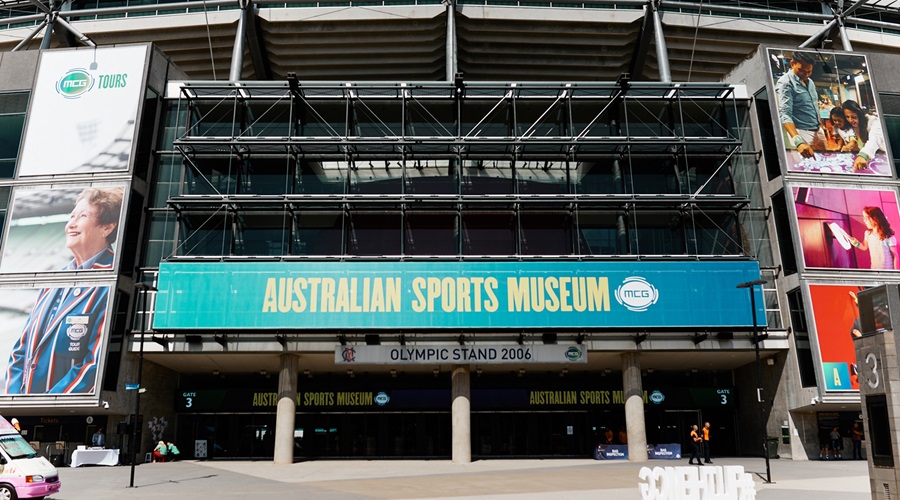
By John Harms
Over the past year or so, what was formerly the National Sports Museum at the MCG (just near Gate 3) has been renovated, the installations reconfigured and the whole shebang modernised. It has just been opened as the Australian Sports Museum. I do love a good museum – two favourites are the Museum of the Ancient Olympic Games in Olympia, Greece and the British Museum in Russell Square, London. You can spend days in them and still feel you’ve barely scratched the surface. And I have always loved the Museum at the MCG. So when a mate of mine, MCC member Keiran Dempsey, a history teacher at Scotch College in Melbourne, invited a few of us along to have a sneak preview (he was in the process of setting up a class excursion), I jumped at the chance.
As it turned out, by sheer coincidence, three of the four in our group were born in 1962. The young pup in attendance, writer Tony Wilson (who has just released his new book 1989: The Great Grand Final), is a decade younger. So we three oldies have a pretty similar understanding of the world. We can all remember F-Troop and Felix the Cat, Gilligan and Jethro, yo-yos, duffel coats, Football the Australian Way and we can sing every verse of ‘Livin’ Next Door to Alice’. And Tony, who was on the tail-end of such classics, knows about that stuff anyway.
That was the nature of popular culture back then. That’s what happened when metropolitan Australia had access to just four TV channels and a couple of newspapers, and country Australia even less. And the so-called traditional Australian sports dominated media coverage. People have many shared experiences.
The four in our group are all sports nuts. We grew up with sport, especially footy and cricket, tennis and athletics, swimming and a few others as well. I can’t remember life without footy. It was just part of what we did and who we were. Games and results and replays and then we would read the match reports in the paper. The Ladder. That page with all the country league scores. It was immediate. Every weekend. Every Monday morning.
But I also remember discovering the history of sport; discovering books of sporting information like the ABC Cricket Book and that vital encyclopedia, as important as the RSV Bible, the Ampol Book of Australian Sporting Records. I committed to memory lists of VFL premiers, Brownlow Medallists, Melbourne Cup winners, Bathurst 500 winners, Australian Open Winners, Wimbledon winners, the venues of the modern Olympic Games and the Commonwealth Games, FA Cup winners, and so on. I learnt of the Austral Wheel Race, and billiards champions, and boxers and wood-chopping and the Sydney to Hobart.
I chanced on some other sporting books. My father had a collection of old cricket books from the 1950s like The Ashes Crown the Year. Then I found a book by Keith Dunstan called Sports. Wow! Literally, wow! The results pages, lively enough as list of teams and dates and people, came to life when I read the stories of great characters and great matches. I devoured these old books and was left wanting more. I have spent a lifetime looking for more, and sometimes finding more.
I didn’t have the chance to get to museums. Living in the bush, we rarely made the trip to the Big Smoke. And it was the days before mobile phones (in Oakey we still took calls from the Goombungee manual exchange), when there were no photo-copiers (just the pungent spirit of the roneo handouts in Grade 9 Geography) and to learn computer programming you had to colour in the dots on cards.
How things have changed! And so museums have changed. They have retained much of what has made them good – displays of items from their vast collections. And, in the case of the Australian Sports Museum, they have used digital technology to convey the stories of these installations. Tap here. Swipe now. Here’s the basic story of the installation in front of you. And here’s some more information.
It’s very much directed at children (check out the website here) and to people coming to topics for the first time. It is engaging and interactive. It’s extensive but spacious and uncluttered.
It’s the sort of place to which you can return many times. Maybe for an hour in the lead-up to a game to take in one section. And then two weeks’ later, another section.
Kids will be introduced to new things. Those who are developing a love of sport and its history will have their curiosity piqued. The more curious will leave, ready to use their own devices to find out more through the vast amount of material available now on-line. (Imagine if Cricinfo existed when I was a kid). I would also encourage these kids to wander a few floors up to see what’s in the brilliant MCC Library which has one of the finest collections of sports books in the world.
These days kids have opportunity to enjoy the best of both worlds.
As for us old blokes, after taking it all in, we headed to the Committee Room to engage in some research of our own.
John Harms’s love of sport and sports history led to a lifetime of research and writing. He curates the sports writing website www.footyalmanac.com.au
